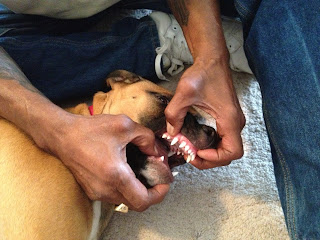As part of raising a well balanced dog, its important to remember the little things as well. This month's trainer tip is about not only preparing your dog for regular vet visits, but reinforcing your leadership as well.
I always encourage clients to do everything the vet might do when they go for a visit (aside from drawing blood). These means you should practice things like touching your dog's paws and looking inside your dog's mouth and ears. Doing these types of things helps your dog learn to remain calm during a vet visit, but also reasserts your position as the leader. It's also a good idea to check your dog over for fleas and ticks every so often.
To practice this, I check my dog's entire body over about once a week. I will run my hands through the fur over their entire body, looking for bumps or unusual marks and parasites like ticks. Starting this process by going over your dog's coat is the best way, because you can very easily make the experience pleasant by treating it like attention, petting, and a doggie massage. Don't forget to touch along the dog's tail, and lift it up as well. Many times vets will need to take a rectal temperature if your dog is sick.
After your pet has relaxed a little, move onto the dog's legs. Touch and slightly squeeze your dog's legs from the top all the way down (this is how vets may check for a leg injury). It is important to touch the feet and look between the dog's pads as well. Get your dog comfortable having his legs and/or feet held and examined by you. Remember to always remain calm.
After you have examined the rest of the dog's body, move onto the head. Again start by treating the exercise like a massage, with petting and praise for calm behavior. Hold the dog's head in your hands and slowly move it side to side as a vet would do to examine them. Look into your dogs ears and touch them. Finally lift the jowls of the dog's mouth to examine the teeth, then open your dog's mouth and look inside.
All of these exercises will come more naturally to the dog the more that you practice them. Again, the number one thing to keep in mind is to STAY CALM, but firm. Do not perform this exercise if you are not in the correct state of mind.
These exercises will make your vet visits much more enjoyable and less stressful for both you and your dog, and your veterinarian as well. In the future if your dog ever ends up having any health issues, it will be easier for you to apply the necessary medication or treatment to keep your loved one happy and healthy.
Below are some pictures of this exercise.
Dora and her owner will demonstrate.
Check the dog's body.
Go down each leg squeezing just a little.
Check the paws.
While examining the dog's body,
be sure to look for unusual marks, lumps, and ticks/ parasites.
Treat this like a massage for your dog as you move your hands around.
Go down the back legs and lift the tail.
Don't forget the paws.
Check inside the dog's ear.
Lift the gums and check the teeth.
Open the dog's mouth and look inside.
It is also a good idea to have your dog used to
being grabbed by the scruff of the neck without reacting in a negative way.
Their practice payed off and Dora was very good at the vet.
Such a sweet girl!
Good job Dora!
























.jpg)




























